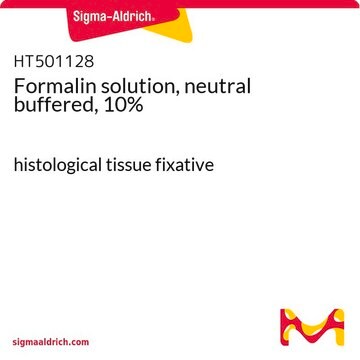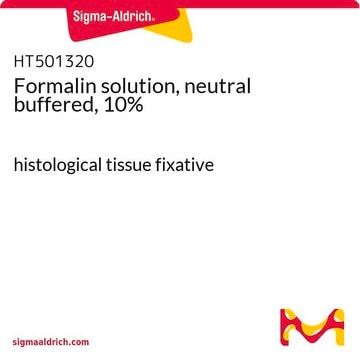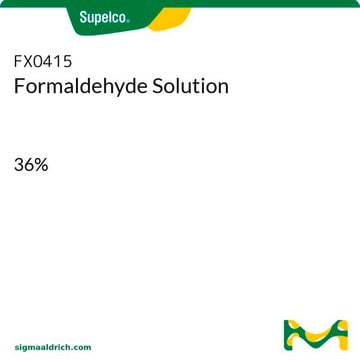The temperature used for standard tissue processing historically has been room temperature. Temperature can affect the rate of fixation, and modern tissue processors may use elevated temperatures to reduce processing time without adverse effects on tissue morphology. Cold fixation is common in electron microscopy when using glutaraldehyde as a fixative.
1.00496
Formaldehyde solution 4%, buffered, pH 6.9
(approx. 10% Formalin solution) for histology
Sinónimos:
Formaline solution, Methanal solution, Methyl aldehyde solution
About This Item
hematology
histology
Productos recomendados
Quality Level
form
liquid
IVD
for in vitro diagnostic use
concentration
3.8-4.2% (acidimetric)
color
colorless
pH
6.7-7.1 ( in H2O)
bp
100 °C/1013 hPa
mp
-92 °C
density
1.017 g/cm3 at 20 °C
application(s)
diagnostic assay manufacturing
hematology
histology
storage temp.
15-25°C
General description
signalword
Danger
Hazard Classifications
Acute Tox. 4 Inhalation - Acute Tox. 4 Oral - Carc. 1B - Muta. 2 - Skin Sens. 1
Storage Class
6.1D - Non-combustible, acute toxic Cat.3 / toxic hazardous materials or hazardous materials causing chronic effects
wgk_germany
WGK 3
flash_point_f
Not applicable
flash_point_c
Not applicable
Certificados de análisis (COA)
Busque Certificados de análisis (COA) introduciendo el número de lote del producto. Los números de lote se encuentran en la etiqueta del producto después de las palabras «Lot» o «Batch»
¿Ya tiene este producto?
Encuentre la documentación para los productos que ha comprado recientemente en la Biblioteca de documentos.
Los clientes también vieron
Protocolos
How to stain organoids? A complete step-by-step protocol for immunofluorescent (IF) and immunocytochemical (ICC) staining of organoid cultures using antibodies
How to stain organoids? A complete step-by-step protocol for immunofluorescent (IF) and immunocytochemical (ICC) staining of organoid cultures using antibodies
How to stain organoids? A complete step-by-step protocol for immunofluorescent (IF) and immunocytochemical (ICC) staining of organoid cultures using antibodies
How to stain organoids? A complete step-by-step protocol for immunofluorescent (IF) and immunocytochemical (ICC) staining of organoid cultures using antibodies
Contenido relacionado
Learn about the criticality of biological tissue staining for research and clinical pathology using standard and special stains and dyes.
Conocer la criticidad de la tinción de los tejidos biológicos para investigación y anatomía patológica utilizando colorantes y tintes convencionales y especiales.
-
Is it okay to fix an entire tissue with 4% PFA at 37°C overnight using product 1004960700 without altering its morphology?
1 answer-
Helpful?
-
-
Do 4% formaldehyde or 10% formalin solutions contain traces of methanol?
1 answer-
Product 1004960700 and all other formaldehyde or formalin solutions contain methanol to prevent the formaldehyde from reforming as a polymer or escaping as a gas. If a methanol-free solution is required, paraformaldehyde powders or crystals can be purchased and prepared into methanol-free solutions, although these solutions are unstable and should be prepared fresh daily or kept for only short periods of time.
Helpful?
-
Active Filters
Nuestro equipo de científicos tiene experiencia en todas las áreas de investigación: Ciencias de la vida, Ciencia de los materiales, Síntesis química, Cromatografía, Analítica y muchas otras.
Póngase en contacto con el Servicio técnico








